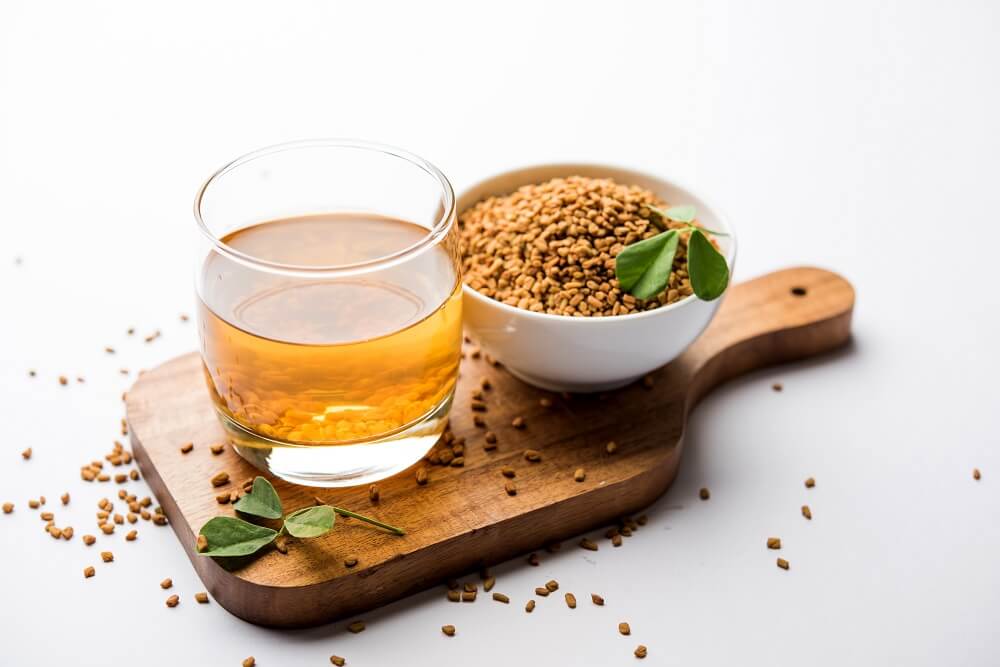Food & Recipes
5 Reasons Why You Should Eat Fenugreek Seeds Daily
Published
4 years agoon
By
Nupur

Methi or Fenugreek is the seeds with green leaves rich and comes from the green pea family. There are so many Methi seeds benefits like methi seeds are bitter and used to form various medicines.
But yes, when these soaked fenugreek seeds are cooked, they are so excellent and tasty. Everyone in their childhood tries to run from methi seeds, but what they are not aware of is its benefits as one spoon of methi seeds contain fats, carbohydrates, protein, and calorie. So let’s focus on some of the reasons which tell you to eat methi daily.
Table of Contents
5 Benefits Of Methi Seeds
1. HAIR RECOVERY
Many people are confused about how to eat fenugreek seeds daily. A straightforward answer to this would by soaking the seeds overnight and eating fenugreek seeds early morning.
Methi seeds are known to have a very significant impact on the scalp, which also turns hair black and helps recover the hair. If you soak the seeds overnight, boiled them, and mix them with coconut oil, they can do exceptionally well for your shiny hair. They are well known for these hair recovery purposes.
2. LOSE WEIGHT


If anyone wants to explain the Methi seeds benefits, this is crucial to describe its services nicely. Not only methi seeds but methi water for weight loss is also an excellent method to reduce weight. When consumed in the morning, the natural content of these fenugreek seeds possesses extra help and curb hunger.
These seeds swell and shallow in the stomach and provide an excellent feeling. As we all know, methi is considered under green vegetables, yet it is another method for improving health and your skin.
3. IMPROVES INFLAMMATION
Methi seeds and fenugreek water are well-deserved elements to address inflammation like coughs, mouth ulcers, cancer, etc. There are so many fenugreek water benefits as it improves acne, provides a fresh feeling every morning, etc. The fenugreek seeds slow down the intake of sugar and process insulin. These seeds or water can be consumed daily in the form of a paste with food to access several body inflammations. If you take Fenugreek seeds or methi seeds benefits daily, your skin and health will surely improve correctly.
4. REDUCES RISK OF HEART DISEASE


No doubt, methi seeds benefits are more than any other vegetable! Due to some social type of tissue in your body, fenugreek seeds play a crucial element in maintaining your good heart health.
High tissue and methi water also provide a high amount of calcium and potassium to control heart rate and Blood pressure. Drinking methi soup also possesses an excellent offer for your heart to stay safe and healthy as methi soups also include the rich methi seeds, which have every nutrient into it.
5. HELPS ACID REFLUX
Only one spoon of fenugreek seeds or one glass of fenugreek water is enough for an effective remedy against acid reflux. The power of Methi seeds benefits helps to digest your food and other diseases only by its natural, compelling play. The roots of methi help form a covering line at the stomach and intestine, which improves tissue. Soaking these seeds also has a good result.
Final Word
There are numerous methi seeds benefits when we explore them. A few things say that pregnant women should not consume methi as it would lead to contraction early and can lead to disability in the child. But taking methi seeds and water has other benefits, like improving skin tones and making a good health. So don’t get rid of Fenugreek and start eating them daily.
About the author


Nupur
Nupur is a graduate from Delhi University and is a passionate writer. Very fond of reading books and listening to old songs!
- August 26, 2020
- August 31, 2020
- September 4, 2020
- October 5, 2020
Nupur is a graduate from Delhi University and is a passionate writer. Very fond of reading books and listening to old songs!


You may like
Food & Recipes
Wild Lettuce: Know Wild Lettuce Benefits, Side Effects & More
Wild lettuce, scientifically known as Lactuca virosa, is a biennial plant belonging to the Asteraceae family. Native to Europe and Asia, this herbaceous species is widely cultivated for its medicinal and culinary uses.
Published
11 months agoon
May 17, 2024By
David

Table of Contents
- 1 What is Wild Lettuce?
- 1.1 Can We Eat Wild Lettuce
- 1.2 The Medicinal Uses of Wild Lettuce
- 1.2.1 1. Pain relief:
- 1.2.2 2. Sedative properties:
- 1.2.3 3. Anxiety and stress relief:
- 1.2.4 4. Respiratory support:
- 1.2.5 5. Digestive aid:
- 1.2.6 6. Mild diuretic:
- 1.2.7 7. Anti-inflammatory effects:
- 1.2.8 8. Nervous system support:
- 1.2.9 9. Menstrual cramp relief:
- 1.2.10 10. Fever reducer:
- 1.2.11 11. Antispasmodic properties:
- 1.2.12 12. Liver support:
- 1.2.13 13. Hypnotic effects:
- 1.2.14 14. Traditional remedy for opiate withdrawal:
- 1.2.15 15. Skin conditions:
- 1.3 Potential Side Effects of Wild Lettuce
- 1.3.1 1. Allergic reactions:
- 1.3.2 2. Gastrointestinal discomfort:
- 1.3.3 3. Drowsiness and dizziness:
- 1.3.4 4. Hypotension:
- 1.3.5 5. Photosensitivity:
- 1.3.6 6. Potential drug interactions:
- 1.3.7 7. Liver toxicity:
- 1.3.8 8. Respiratory depression:
- 1.3.9 9. Pregnancy and breastfeeding:
- 1.3.10 10. Psychological effects:
- 1.3.11 About the author
What is Wild Lettuce?
Wild lettuce, scientifically known as Lactuca Virosa, is a biennial plant belonging to the Asteraceae family. Native to Europe and Asia, this herbaceous species is widely cultivated for its medicinal and culinary uses. Also referred to as “opium lettuce” due to its mild sedative effects, wild lettuce has a long history of traditional use dating back to ancient civilizations.
The plant has deeply lobed leaves and little yellow flowers that bloom in bunches. It normally reaches a height of 3 to 7 feet. You can find wild lettuce growing in meadows, woodlands, and by the sides of roads in temperate areas. Because of its adaptability and persistence, it is frequently seen in both urban and rural environments.
Wild lettuce has long been valued for its medicinal qualities as well as being seen as a representation of life and wellbeing. Ancient societies, including the Greeks, Romans, and Egyptians, appreciated the sedative, analgesic, and anti-inflammatory qualities of wild lettuce. It was frequently applied to reduce pain, encourage calmness, and bring on sleep.
In contemporary times, wild lettuce continues to be cherished for its medicinal benefits and is widely used in herbal medicine practices around the world. Its leaves and sap contain a milky latex substance known as lactucarium, which is rich in bioactive compounds such as lactucin and lactucopicrin. These compounds are believed to contribute to the plant’s sedative and analgesic effects, making it a popular remedy for conditions such as insomnia, anxiety, and migraine headaches.
Despite its long history of traditional use, wild lettuce remains a subject of scientific inquiry, with ongoing research aimed at uncovering its pharmacological properties and potential therapeutic applications. As interest in natural remedies and alternative medicine continues to grow, wild lettuce holds promise as a valuable botanical resource for promoting health and well-being.
Can We Eat Wild Lettuce
The answer is that wild lettuce is edible, and you can eat the leaves and stems of the plant. Nevertheless, care must be taken when gathering and cooking wild lettuce for eating. Some people may find the bitter flavour of certain wild lettuce species to be intolerable.
Furthermore, some people may respond negatively to some substances found in wild lettuce, particularly if they ingest excessive amounts of it or if they have particular sensitivities or allergies.
Consequently, it is best to start modestly while consuming wild lettuce in order to monitor your body’s response and make sure the plant is being harvested in a clean and healthy setting.
As with any wild plant, it is crucial to positively identify the species and to avoid harvesting from areas that may be exposed to pollutants or pesticides. If you have any concerns or medical conditions, it is best to consult with a healthcare professional before consuming wild lettuce or any other wild plant for culinary or medicinal purposes.
The Medicinal Uses of Wild Lettuce
Wild lettuce has a long history of use in traditional medicine for its various medicinal properties. From alleviating pain to promoting relaxation, this versatile plant offers a range of therapeutic benefits that have been recognized and valued for centuries.
1. Pain relief:
Wild lettuce has been traditionally used to alleviate pain associated with various conditions such as headaches, muscle aches, and joint pain. Research suggests that wild lettuce contains compounds like lactucin and lactucopicrin, which exhibit analgesic properties by acting on the central nervous system to reduce pain perception (source).
2. Sedative properties:
The milky sap of wild lettuce contains lactucarium, a substance known for its sedative effects. Studies have shown that lactucarium acts as a mild sedative and can help promote relaxation and improve sleep quality (source).
3. Anxiety and stress relief:
Wild lettuce may help alleviate symptoms of anxiety and stress due to its calming effects on the nervous system. Research indicates that wild lettuce extracts have anxiolytic properties, making them useful in managing stress and anxiety (source).
4. Respiratory support:
Wild lettuce has been used to relieve respiratory conditions such as asthma and bronchitis. Studies suggest that compounds in wild lettuce possess expectorant and bronchodilator effects, which can help improve breathing and relieve coughs (source).
5. Digestive aid:
The bitter compounds in wild lettuce can stimulate digestive function, improve appetite, and alleviate symptoms of indigestion. Research shows that wild lettuce extracts may have gastroprotective effects and help reduce gastric acid secretion (source).
6. Mild diuretic:
Wild lettuce can act as a mild diuretic, promoting urine production and helping to eliminate excess fluid and toxins from the body. Studies suggest that wild lettuce extracts may increase urine output and support kidney function (source).
7. Anti-inflammatory effects:
Compounds found in wild lettuce may help reduce inflammation and swelling, making it beneficial for conditions such as arthritis. Research indicates that wild lettuce extracts exhibit anti-inflammatory activity by inhibiting inflammatory mediators (source).
8. Nervous system support:
Wild lettuce is believed to have a tonic effect on the nervous system, helping to calm nerves and reduce irritability. Studies suggest that wild lettuce extracts may modulate neurotransmitter levels in the brain, contributing to its calming effects (source).
9. Menstrual cramp relief:
Some women use wild lettuce to alleviate menstrual cramps and discomfort during menstruation. While scientific research on this specific use is limited, anecdotal evidence suggests that wild lettuce may help reduce menstrual pain and cramping.
10. Fever reducer:
Wild lettuce has been traditionally used to lower fever and promote sweating during febrile illnesses. However, more research is needed to fully understand its mechanisms of action and effectiveness in reducing fever.
11. Antispasmodic properties:
Wild lettuce may help relieve muscle spasms and cramps due to its antispasmodic effects on smooth muscle tissue. Studies suggest that wild lettuce extracts can relax muscle contractions and alleviate spasms (source).
12. Liver support:
Consuming wild lettuce may support liver function and detoxification processes. While there is limited direct research on this aspect, the liver-supporting properties of bitter herbs like wild lettuce are well-documented in traditional medicine (source).
13. Hypnotic effects:
Wild lettuce preparations have been used to induce a state of mild euphoria and relaxation, promoting restful sleep and reducing insomnia. Studies suggest that wild lettuce extracts may have sedative-hypnotic effects, aiding in sleep induction (source).
14. Traditional remedy for opiate withdrawal:
Wild lettuce has been historically used as a natural remedy to help ease symptoms of opiate withdrawal, such as anxiety, restlessness, and insomnia. While scientific evidence is limited, anecdotal reports suggest that wild lettuce may offer relief during the withdrawal process.
15. Skin conditions:
Wild lettuce sap has been applied topically to soothe skin irritations, rashes, and insect bites. While there is limited scientific research on this specific use, the anti-inflammatory and analgesic properties of wild lettuce may help alleviate skin discomfort (source).
Potential Side Effects of Wild Lettuce
1. Allergic reactions:
Some individuals may experience allergic reactions to wild lettuce, leading to symptoms such as skin rash, itching, swelling, or difficulty breathing. Allergic reactions can vary in severity, and it’s essential to discontinue use if any adverse reactions occur (source).
2. Gastrointestinal discomfort:
Consuming wild lettuce may cause gastrointestinal discomfort in some people, including symptoms like nausea, vomiting, diarrhea, or abdominal pain. These effects can be due to the bitter compounds present in wild lettuce, which may irritate the digestive tract (source).
3. Drowsiness and dizziness:
Wild lettuce’s sedative properties may cause drowsiness or dizziness, especially when consumed in large amounts or in combination with other sedative substances. These effects can impair cognitive function and motor skills, increasing the risk of accidents or injuries (source).
4. Hypotension:
Some individuals may experience a drop in blood pressure after consuming wild lettuce, leading to symptoms of hypotension such as lightheadedness, fainting, or weakness. Individuals with low blood pressure or those taking antihypertensive medications should use wild lettuce with caution (source).
5. Photosensitivity:
Certain compounds in wild lettuce sap may increase sensitivity to sunlight, leading to sunburn or skin irritation upon exposure to UV rays. Individuals using wild lettuce topically should avoid prolonged sun exposure to prevent skin reactions (source).
6. Potential drug interactions:
Wild lettuce may interact with certain medications, including sedatives, antihypertensives, and blood thinners. These interactions can potentiate the effects of medications or interfere with their metabolism, leading to adverse reactions or reduced efficacy (source).
7. Liver toxicity:
In rare cases, excessive consumption of wild lettuce may lead to liver toxicity or liver damage. This adverse effect is more likely to occur with prolonged or high-dose use of wild lettuce preparations (source).
8. Respiratory depression:
Wild lettuce’s sedative properties may cause respiratory depression in susceptible individuals, particularly those with respiratory conditions like asthma or chronic obstructive pulmonary disease (COPD). Respiratory depression can lead to breathing difficulties or even respiratory failure in severe cases (source).
9. Pregnancy and breastfeeding:
Pregnant and breastfeeding women should avoid using wild lettuce due to a lack of safety data. Wild lettuce may exert uterine-stimulating effects and pose risks to fetal development or infant health (source).
10. Psychological effects:
In some cases, wild lettuce may induce psychological effects such as confusion, hallucinations, or altered perception. These effects are more likely to occur with high doses or prolonged use of wild lettuce and can be distressing or disorienting (source).
About the author
David is a blogger for over 15 years now and writes on health and wellness. The articles are focused to give extensive information about the subject.
- June 30, 2020
- June 30, 2020
- June 30, 2020
Food & Recipes
Best Juices To Boost Immune System For a Stronger Defense
Published
1 year agoon
April 3, 2024By
Charlotte

In today’s fast-paced world, maintaining a robust immune system is crucial for overall health and well-being. While a balanced diet rich in fruits and vegetables forms the cornerstone of immune health, incorporating immunity-boosting juices into your daily routine can provide an extra layer of protection against illness. In this comprehensive guide, we delve into the benefits of immunity-boosting juices and share delicious recipes to help fortify your body’s natural defenses.
Table of Contents
Immunity Booster Drink: The Power of Healthy Juices
1. Watermelon-Mint Immunity Juice:


- Ingredients: Fresh watermelon chunks, mint leaves, lime juice.
- Benefits: Watermelon is a rich source of vitamin C, antioxidants, and electrolytes, making it an ideal ingredient for boosting immune function. Mint leaves not only impart a refreshing flavor but also contain compounds that support digestion and overall well-being. Lime juice adds an extra dose of vitamin C, further enhancing the immune-boosting properties of this juice.
- Recipe: To prepare this refreshing elixir, simply blend fresh watermelon chunks and mint leaves until smooth. Squeeze in some fresh lime juice for added zest. Serve chilled for a hydrating and invigorating boost to your immune system.
Nutrients
- Vitamin C from watermelon and lime
- Hydration from watermelon and coconut water
- Antioxidants from watermelon and mint
2. Citrus Immunity Blast:


- Ingredients: Oranges, grapefruits, lemons, ginger.
- Benefits: Citrus fruits like oranges, grapefruits, and lemons are renowned for their high vitamin C content, which plays a crucial role in supporting immune health. These fruits also provide essential antioxidants that help combat oxidative stress and inflammation. Ginger adds an extra layer of immune support with its anti-inflammatory and antimicrobial properties.
- Recipe: Juice fresh oranges, grapefruits, and lemons to extract their vibrant and tangy flavors. Add freshly grated ginger for an additional boost of immune-boosting goodness. Enjoy this invigorating citrus blast over ice for a refreshing and revitalizing way to support your immune system.
Nutrients
- Vitamin C from oranges and lemons
- Vitamin A from carrots
- Antioxidants from oranges, carrots, and turmeric
- Hydration from coconut water
3. Green Goddess Elixir:


- Ingredients: Spinach, kale, cucumber, apples, lemon.
- Benefits: Eating leafy greens like spinach and kale are nutritional powerhouses, packed with vitamins A, C, and K, as well as essential minerals and antioxidants. These nutrients help bolster immune function and protect against illness. Cucumber adds hydration and a refreshing crunch, while apples and lemon provide natural sweetness and acidity.
- Recipe: Blend together fresh spinach, kale, cucumber, apples, and lemon until smooth. Strain the mixture if desired, then sip on this nutrient-rich elixir to nourish your body and support your immune system. This Green Goddess Elixir is a delicious and rejuvenating way to boost your overall health.
Nutrients
- Vitamin A, C, and K from spinach and cucumber
- Calcium from spinach
- Iron from spinach
- Magnesium from spinach and cucumber
- Potassium from spinach and cucumber
- Antioxidants from spinach, cucumber, celery, and lemon
- Hydration from cucumber and celery
- Detoxifying properties from spinach, cucumber, celery, lemon, and parsley
4. Berry Blast Immunity Booster:


- Ingredients: Mixed berries (strawberries, blueberries, raspberries), spinach, Greek yogurt, honey.
- Benefits: Berries are packed with antioxidants, vitamins, and minerals that help strengthen the immune system and protect against free radical damage. Spinach adds additional vitamins and minerals, while Greek yogurt contributes probiotics that support gut health and overall immune function. Honey provides natural sweetness and antimicrobial properties.
- Recipe: Blend together a mix of fresh berries, spinach, Greek yogurt, and honey until smooth and creamy. Adjust the sweetness to taste, then enjoy this delicious and nutritious Berry Blast Immunity Booster as a satisfying snack or meal replacement. This vibrant and flavorful juice is sure to keep your immune system strong and resilient.
Nutrients
- Vitamin C from strawberries and oranges
- Antioxidants from berries and spinach
- Fiber from berries and spinach
- Hydration from coconut water
5. Tropical Turmeric Tonic:


- Ingredients: Pineapple, mango, turmeric root, ginger, coconut water.
- Benefits: Pineapple and mango are tropical fruits rich in vitamins A and C, which are essential for immune function. Turmeric and ginger both have potent anti-inflammatory and antioxidant properties that can help strengthen the immune system and reduce inflammation. Coconut water provides hydration and electrolytes, making this tonic both refreshing and nourishing.
- Recipe: Blend together chunks of fresh pineapple and mango with grated turmeric root, ginger, and coconut water until smooth. Strain the mixture if desired, then pour into glasses and garnish with a slice of pineapple or a sprig of mint. Sip on this Tropical Turmeric Tonic to give your immune system a tropical boost and enjoy the vibrant flavors of the islands.
Nutrients
- Vitamin C from pineapple
- Antioxidants from pineapple, mango, turmeric, and ginger
- Electrolytes and hydration from coconut water
6. Beetroot Bliss Booster:


- Ingredients: Beetroot, carrots, oranges, ginger, honey.
- Benefits: Beetroot is rich in immune-boosting nutrients like vitamin C, folate, and manganese, as well as powerful antioxidants called betalains. Carrots provide additional vitamins and minerals, while oranges add a zesty burst of vitamin C. Ginger and honey contribute antimicrobial properties and natural sweetness, respectively.
- Recipe: Juice fresh beetroot, carrots, and oranges to extract their vibrant colors and flavors. Add freshly grated ginger and a drizzle of honey to enhance the taste and nutritional value. Enjoy this Beetroot Bliss Booster as a delicious and invigorating way to support your immune system and promote overall health.
Nutrients
- Vitamin C from oranges
- Folate, manganese, and betalains from beetroot
- Antioxidants from beetroot, carrots, and oranges
7. Pomegranate Power Punch:


- Ingredients: Pomegranate seeds, strawberries, spinach, lemon, honey.
- Benefits: Pomegranate seeds are packed with antioxidants, particularly punicalagins and anthocyanins, which help boost immune function and reduce inflammation. Strawberries provide additional vitamin C and fiber, while spinach adds vitamins A and K. Lemon adds a citrusy kick and extra vitamin C, while honey lends natural sweetness and antimicrobial properties.
- Recipe: Blend together fresh pomegranate seeds, strawberries, spinach, lemon juice, and honey until smooth and creamy. Pour into glasses and garnish with a slice of lemon or a few pomegranate arils. Sip on this vibrant and nutrient-rich Pomegranate Power Punch to give your immune system a powerful boost and enjoy the delicious flavors of summer.
Nutrients
- Vitamin C from pomegranate seeds and lemon
- Antioxidants from pomegranate seeds, strawberries, and spinach
- Fiber from strawberries and spinach
8. Detoxifying Green Cleanse:
- Ingredients: Cucumber, celery, kale, green apples, lemon, parsley.
- Benefits: This green juice is packed with detoxifying ingredients that help cleanse the body and support immune health. Cucumber and celery are hydrating and low in calories, while kale provides vitamins A, C, and K. Green apples add natural sweetness, while lemon and parsley provide additional vitamin C and antioxidants.
- Recipe: Juice together cucumber, celery, kale, green apples, lemon juice, and parsley until well combined. Strain the mixture if desired, then pour into glasses and enjoy this Detoxifying Green Cleanse as a refreshing and revitalizing way to support your immune system and promote overall wellness.
Nutrients
- Vitamin A, C, and K from kale
- Hydration from cucumber and celery
- Detoxifying properties from kale, cucumber, celery, and parsley
By incorporating these immunity-boosting juices into your daily routine, you can provide your body with the essential nutrients it needs to stay healthy and resilient. Whether enjoyed as a refreshing beverage or a post-workout pick-me-up, these delicious juices offer a convenient and delicious way to support your immune system and promote overall well-being.
About the author



Charlotte
Charlotte is a health, beauty and wellness blogger and a mother of two, who lives between India and London
- July 22, 2020
- August 3, 2020
- August 10, 2020
Food & Recipes
Diabetic-Friendly Delights: Nourishing Recipes for Managing Blood Sugar
Living with diabetes necessitates meticulous attention to your diet to maintain optimal blood sugar levels and overall health. Through a carefully curated selection of recipes and insightful guidance, this comprehensive guide is designed to empower you with the knowledge
Published
1 year agoon
March 26, 2024By
Charlotte

Living with diabetes necessitates meticulous attention to your diet to maintain optimal blood sugar levels and overall health. Through a carefully curated selection of recipes and insightful guidance, this comprehensive guide is designed to empower you with the knowledge and tools to make informed dietary choices that support blood sugar control while savoring the pleasures of a delicious and nourishing meal plan.
Table of Contents
Understanding Diabetes Management Through Diet


Embark on a journey into the realm of diet and diabetes, where the crucial link between what you eat and blood sugar control becomes evident. This section delves into the nuances of balancing your diet to maintain stable blood sugar levels, revealing how strategic meal planning contributes to overall wellness.
The Importance of Balanced Nutrition
Discover the power of balanced nutrition in managing diabetes. We unravel the significance of incorporating nutrient-rich foods that provide essential vitamins, minerals, and antioxidants while helping to keep blood sugar levels in check. Learn how to create harmonious meals that cater to your taste buds and your health.
Incorporating Low Glycemic Index (GI) Foods


Navigate the world of glycemic index foods, where the speed at which carbohydrates affect blood sugar levels is demystified. Dive into a selection of low GI recipes that embrace wholesome ingredients, allowing you to indulge in satisfying meals without compromising blood sugar control.
Sweetening Naturally
Bid farewell to refined sugars and explore the realm of natural sweeteners. Delve into alternatives such as stevia, monk fruit, and honey, discovering innovative ways to infuse sweetness into your dishes while maintaining stable blood sugar levels.
Protein-Packed Pleasures


Unlock the secrets of protein’s role in managing diabetes. Beyond its muscle-building attributes, protein contributes to steady blood sugar levels. Explore a variety of high-protein meals, recognizing how they promote muscle health and assist in maintaining balanced glucose levels.
Smart Carbohydrate Choices
Navigate the complex world of carbohydrates with wisdom. Discover how to identify diabetes-friendly carbs, explore the benefits of whole grains, and understand the impact of carbohydrates on blood sugar levels. Make informed choices to enjoy sustained energy and well-being.
Heart-Healthy Fats


Learn the importance of heart-healthy fats in diabetes care. This section highlights the significance of omega-3 fatty acids and monounsaturated fats, shedding light on their role in supporting cardiovascular health and blood sugar management.
Healthy Cooking Methods
Discover the art of cooking for blood sugar control. Uncover cooking methods that preserve nutrients and flavors while minimizing the impact on blood sugar levels. From grilling to steaming, explore techniques that elevate your culinary endeavors.
Colorful Fruits and Vegetables


Embrace a vibrant palette of fruits and vegetables that not only add color to your plate but also offer a treasure trove of essential nutrients. The rainbow diet is unveiled, showcasing how these nutrient-rich foods can contribute to your overall well-being.
Diabetes and Hydration


Staying hydrated is often overlooked in diabetes care. Recognize the profound influence of proper hydration on blood sugar management and overall health. Learn about the role of water intake in supporting your well-being.
Embrace this journey toward diabetic-friendly delights, where each recipe and insight is tailored to empower you in your pursuit of balanced blood sugar levels and holistic well-being. By understanding the nuances of nutrition, making informed food choices, and crafting meals that harmonize with your diabetes management goals, you’re embarking on a path of wellness that nourishes both body and spirit.
Living with diabetes doesn’t mean sacrificing flavor or indulgence. In fact, it’s an opportunity to explore a world of delectable and nourishing dishes that support your blood sugar management while satisfying your taste buds. This blog presents a collection of mouthwatering recipes that embrace the principles of balanced nutrition, low glycemic index (GI) foods, and mindful ingredient choices. Get ready to embark on a culinary journey that combines taste and health in perfect harmony.
Nourishing Recipes for Managing Blood Sugar
Recipe 1: Quinoa-Stuffed Bell Peppers
Ingredients:
- 4 large bell peppers (any color)
- 1 cup quinoa, rinsed
- 2 cups low-sodium vegetable broth
- 1 can (15 oz) black beans, drained and rinsed
- 1 cup corn kernels (fresh or frozen)
- 1 cup diced tomatoes
- 1 teaspoon cumin
- 1 teaspoon paprika
- Salt and pepper to taste
- Chopped fresh cilantro for garnish
Instructions:
- Preheat the oven to 375°F (190°C).
- Cut the tops off the bell peppers and remove the seeds and membranes.
- In a medium saucepan, bring the vegetable broth to a boil. Add the quinoa, reduce heat to low, cover, and let it simmer for about 15 minutes or until the liquid is absorbed.
- In a large bowl, combine the cooked quinoa, black beans, corn, diced tomatoes, cumin, paprika, salt, and pepper. Mix well.
- Stuff each bell pepper with the quinoa mixture and place them in a baking dish.
- Cover the baking dish with aluminum foil and bake for 25-30 minutes, or until the peppers are tender.
- Garnish with chopped cilantro before serving.
Recipe 2: Baked Salmon with Asparagus
Ingredients:
- 2 salmon fillets
- 1 bunch asparagus, trimmed
- 2 tablespoons olive oil
- 1 lemon, sliced
- 2 cloves garlic, minced
- Salt and pepper to taste
Instructions:
- Preheat the oven to 400°F (200°C).
- Place the salmon fillets and asparagus on a baking sheet lined with parchment paper.
- Drizzle olive oil over the salmon and asparagus. Sprinkle minced garlic, salt, and pepper.
- Place lemon slices on top of the salmon fillets.
- Bake in the preheated oven for about 15-20 minutes or until the salmon flakes easily with a fork and the asparagus is tender.
- Serve with a squeeze of fresh lemon juice.
Recipe 3: Greek Yogurt Parfait
Ingredients:
- 1 cup plain Greek yogurt
- 1/2 cup mixed berries (blueberries, strawberries, raspberries)
- 1 tablespoon chopped nuts (almonds, walnuts)
- 1 teaspoon chia seeds
- 1 teaspoon honey (optional)
Instructions:
- In a glass or bowl, layer half of the Greek yogurt.
- Add a layer of mixed berries on top of the yogurt.
- Sprinkle chopped nuts and chia seeds over the berries.
- Add the remaining Greek yogurt on top.
- Drizzle honey over the yogurt, if desired.
- Enjoy as a nutritious and satisfying dessert or snack.
These recipes exemplify the essence of diabetic-friendly delights—delicious, nutritious, and mindful of blood sugar levels. By incorporating these recipes into your meal plan, you’re embracing a journey of wellness and culinary exploration. Remember, managing diabetes doesn’t mean giving up on the joy of food; it’s about making choices that nourish your body and elevate your overall well-being.
About the author



Charlotte
Charlotte is a health, beauty and wellness blogger and a mother of two, who lives between India and London
- July 22, 2020
- August 3, 2020
- August 10, 2020












